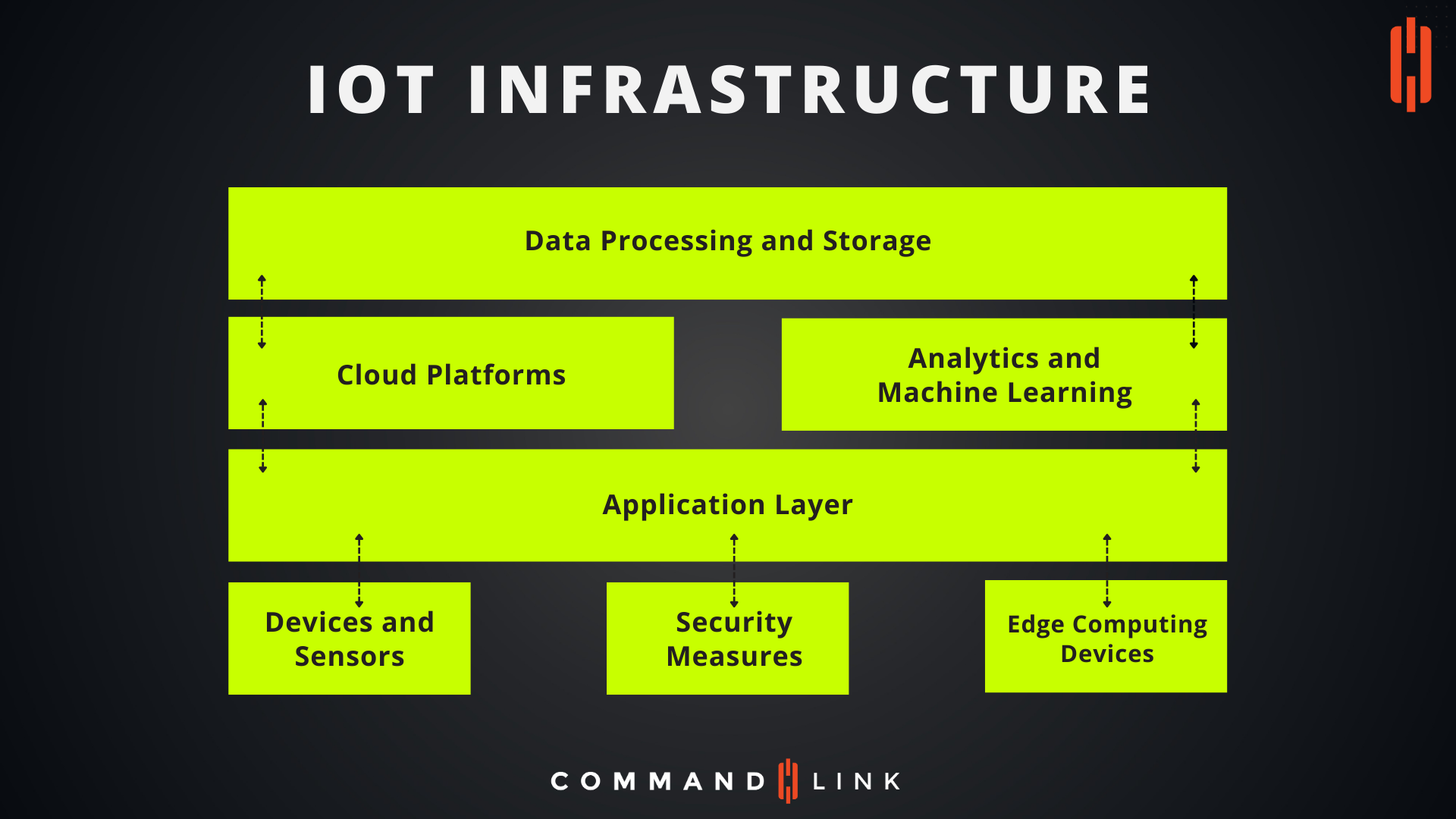Platform
Platform
Everything you need to run a secure global network—in a single system.
Solutions
Solutions
Learn how our solutions were designed to help you scale your IT resources
Company
CommandLink
Let's talk about how we can help you!
Partners

How Does IoT Infrastructure Function?
The Internet of Things (IoT) infrastructure is a complex system designed to connect various devices, sensors, and systems to gather, process, and analyze data. The core of IoT infrastructure revolves around data processing and storage, cloud platforms, and analytics and machine learning. These elements work together to manage the vast amounts of data generated by IoT devices, ensuring that it is processed efficiently and securely. The infrastructure is layered, with each layer handling specific tasks that contribute to the overall functionality of the IoT ecosystem.
What Role Do Devices and Sensors Play in IoT Infrastructure?
Devices and sensors form the foundation of any IoT infrastructure. They are responsible for collecting data from the physical world, such as temperature, humidity, motion, or other environmental factors. These sensors can be embedded in various devices, from household appliances to industrial machines, and they continuously send data to the cloud or local servers for processing. The accuracy and reliability of these sensors are critical, as they provide the raw data necessary for the entire IoT system to function effectively.
Why Are Cloud Platforms Essential in IoT Infrastructure?
Cloud platforms play a crucial role in IoT infrastructure by providing the necessary storage and computing power to handle the large volumes of data generated by IoT devices. These platforms offer scalability, allowing businesses to expand their IoT networks without the need for significant hardware investments. Additionally, cloud platforms facilitate real-time data processing, enabling faster decision-making and more responsive IoT applications. By centralizing data storage and processing, cloud platforms also make it easier to manage and secure IoT data.
How Does the Application Layer Support IoT Operations?
The application layer is the interface between the raw data collected by devices and sensors and the end-user applications that utilize this data. This layer processes the data, applies security measures, and ensures that the information is formatted and delivered in a way that is useful to the end-users. It is in this layer that data is often enriched, filtered, and transformed into actionable insights. The application layer also plays a significant role in implementing security measures, ensuring that data remains secure as it moves through the IoT infrastructure.
What Is the Importance of Analytics and Machine Learning in IoT?
Analytics and machine learning are vital components of IoT infrastructure, as they allow businesses to derive meaningful insights from the massive amounts of data generated by IoT devices. Through advanced algorithms, machine learning models can predict trends, identify patterns, and automate decision-making processes. These technologies enable predictive maintenance, smart resource management, and other advanced IoT applications. Without analytics and machine learning, the vast potential of IoT data would remain untapped, limiting the value that organizations can extract from their IoT investments.
How Do Security Measures Integrate into IoT Infrastructure?
Security is a critical concern in IoT infrastructure, given the widespread connectivity and data exchange between devices, sensors, and cloud platforms. Security measures are integrated at various levels of the infrastructure to protect against unauthorized access, data breaches, and other cyber threats. This includes encryption, authentication protocols, and real-time monitoring systems that detect and respond to potential security incidents. Ensuring robust security within the IoT infrastructure is essential to maintaining the integrity of the data and the reliability of the IoT system as a whole.
Why Are Edge Computing Devices Important in IoT?
Edge computing devices are becoming increasingly important in IoT infrastructure as they allow data processing to occur closer to the source of data generation, rather than relying solely on centralized cloud platforms. This approach reduces latency, improves response times, and decreases the amount of data that needs to be transmitted to the cloud, leading to more efficient IoT operations. Edge computing is particularly beneficial in applications that require real-time data processing, such as autonomous vehicles, industrial automation, and smart cities.
In conclusion, IoT infrastructure is a multi-layered system that relies on a combination of devices, sensors, cloud platforms, application layers, and advanced analytics to function effectively. Each component plays a critical role in ensuring that data is collected, processed, analyzed, and secured in a way that maximizes the potential of IoT technologies. Understanding these components and their interactions is essential for businesses looking to leverage IoT to drive innovation and efficiency in their operations.